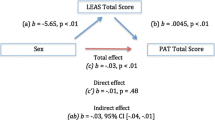Abstract
Emotion perception and perspective-taking skills were examined among women with or without the fragile X gene. The performance of 56 control women was compared to the performance of 46 women who were carriers of the fragile X gene. Twenty-seven of the carrier women had 0–1% cytogenetic expression and did not appear affected by the gene, whereas the remaining 19 women had ≥2% cytogenetic expression and did appear affected by the gene. The emotion perception task employed was one for which deficits have been reported among individuals with autism. The results show that performance on this emotion-perception test and the perspective-taking measure was significantly related to full-scale IQ scores, but not to fragile X group status when effects of IQ were removed. Thus the results do not support the hypothesis that perspective-taking or emotion perception deficits are a component of the fragile X phenotype in females and represent an important differentiation between fragile X and autism.
Similar content being viewed by others
References
Baron-Cohen, S. (1988). Social and pragmatic deficits in autism: Cognitive or affective?Journal of Autism and Developmental Disorders, 18, 379–402.
Carlo, G. Knight, G. P., Eisenberg, N., & Rotenberg, K. J. (1991). Cognitive processes and prosocial behaviors among children: The role of affective attributions and reconciliation.Developmental Psychology, 27, 456–461.
Flavell, J. H., Botkin, P., Fry, C., Wright, J., & Jarvis, P. (1968).The development of role-taking and communication skills in children. New York: Wiley.
Freund, L. S., Reiss, A. L., & Abrams, M. T. (1993). Psychiatric disorders associated with fragile X in the young female.Pediatrics, 91, 321–329.
Frith, U. (1989). A new look at language and communication in autism.British Journal of Disorders of Communication, 24, 123–150.
Grattan, L. M., & Eslinger, P. J. (1989). Higher cognition and social behavior: Changes in cognitive flexibility and empathy after cerebral lesions.Neuropsychology, 3, 1.
Grigsby, J. P., & Myers, C. S. (1987, December).Neuropsychological findings among heterozygous fragile X females. Paper presented at the First National Fragile X Conference, Denver, CO.
Hagerman, R. J. (1991). Physical and behavioral phenotype. In R. J. Hagerman & A. C. Silverman (Eds.),Fragile X syndrome: Diagnosis, treatment, and research. Baltimore: Johns Hopkins University Press.
Hagerman, R. J., Chudley, A. E., Knoll, J. H., Jackson, A. W., Kemper, M., & Ahmad, R. (1986). Autism in fragile X females.American Journal of Medical Genetics, 23, 375–380.
Hagerman, R. J., Jackson, C., Amiri, K., Silverman, A. C., O'Connor, R., & Sobesky, W. (1992). Girls with fragile X syndrome: Physical and neurocognitive status and outcome.Pediatrics, 89, 395–400.
Hobson, R. P. (1989). Beyond cognition: theory of autism. In G. Dawson (Ed.),Autism: New perspectives on diagnosis, nature, and treatment (pp. 22–48). New York: Guilford.
Izard, C. E. (1982).Measuring emotion in infants and children. New York: Cambridge University Press.
Lachiewicz, A. M. (1992). Abnormal behaviors of young girls with fragile X syndrome.American Journal of Medical Genetics, 43, 72–77.
Mazzocco, M. M. M., Hagerman, R. J., Cronister-Silverman, A., & Pennington, B. F. (1992). Specific frontal lobe deficits among women with the fragile X gene.Journal of the American Academy of Child and Adolescent Psychiatry, 31, 1141–1148.
Mazzocco, M. M. M., Pennington B. F., & Hagerman, R. J. (1993). The neurocognitive phenotype of female carriers of fragile X: Further evidence for specificity.Journal of Developmental and Behavioral Pediatrics 14(5) 328–335.
Miezejeski, C. M., & Hinton, V. J. (1992). Fragile X learning disability: Neurobehavioral research, diagnostic models, and treatment options. In R. J. Hagerman & P. McKenzie (Eds.),1992 International Fragile X Conference Proceedings. Dillon, CO: Spectra Publishing Co.
Ozonoff, S., Pennington, B. F., & Rogers, S. J. (1991). Executive function deficits in highfunctioning autistic individuals: Relationship to theory of mind.Journal of Child Psychology and Psychiatry, 32, 1081–1105.
Reiss A. L., Hagerman, R. J., Vingradov, S., Abrams, M., & King, R. J. (1988). Psychiatric disability in female carriers of the fragile X chromosome.Archives of General Psychiatry, 45, 25–30.
Reiss, A. L., & Freund, L. (1990). Fragile X syndrome, DSM-III-R, & autism.Journal of the American Academy of Child and Adolescent Psychiatry, 29, 885–891.
Rourke, B. P. (1989).Nonverbal learning disabilities: The syndrome and the model (pp. 85–105). New York: Guilford.
Staley, L., Hull, C. E., Mazzocco, M. M. M., Thibodeau, S., Snow, K., Wilson, V. L., Taylor, A., McGarran, L., Weiner, D., Riddle, J., O'Connor, R., & Hagerman, R. J. (1993). Molecular clinical correlations in fragile X children and adults.American Journal of Diseases of Childhood, 147, 723–726.
Webb, P., Bundy, S., Thake, A., & Todd, J. (1986). The frequency of the fragile X chromosome among school children in Coventry.Journal of Medical Genetics, 23, 396–399.
Yirmiya, N., Sigman, M. D., Kasan, C., & Mundy, P. (1992). Empathy and cognition in high-functioning children with autism.Child Development, 63, 150–160.
Author information
Authors and Affiliations
Additional information
This research was supported by NIMH Grant MCJOOO252 U.S. Department of Health and Human Services, Bureau of Maternal and Child Health; and by grant MH45916 U.S. National Institutes of Health (NIMH). Randi J. Hagerman and Michele M. M. Mazzocco received additional support from a grant from Joslins Department Store, Denver, Colorado. Hagerman received support from grant RR-69 from the General Clinical Research Program, National Center for Research Resources, National Institutes of Health. Bruce F. Pennington was supported by an RSDA (MH0419) and MERIT award (MH38870) from NIMH, as well as by an NICHD Center Grant (HD27802). The authors thank all the women who participated in the study and Dennis Lucky and Barrett Jeffers from the Kempe Research Center at The Children's Hospital.
Rights and permissions
About this article
Cite this article
Mazzocco, M.M.M., Pennington, B.F. & Hagerman, R.J. Social cognition skills among females with fragile X. J Autism Dev Disord 24, 473–485 (1994). https://doi.org/10.1007/BF02172129
Issue Date:
DOI: https://doi.org/10.1007/BF02172129




